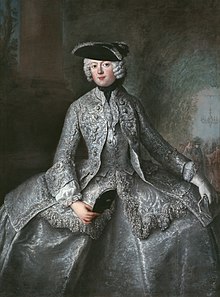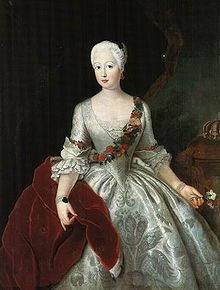Amalie of Prussia

Princess Anna Amalie of Prussia (born November 9, 1723 in Berlin ; † March 30, 1787 there ) was a German composer and the youngest sister of Frederick the Great . From 1756 to 1787 she was abbess of the Quedlinburg monastery .
Life
Amalie, also called Amélie according to French custom, was born on November 9, 1723 as the youngest daughter of King Friedrich Wilhelm I of Prussia and Sophie Dorothea of Hanover . Allegedly, her mother should not have noticed the pregnancy until the end. She grew up with her sister Ulrike . She married the Swedish heir to the throne Adolph Friedrich , Duke of Holstein-Gottorp , who was actually intended for Amalie. However, the youngest sister of Frederick the Great did not want to convert from Calvinism to Lutheranism.
At her sister's wedding in July 1744, Amalie is said to have met the ensign Friedrich von der Trenck . Historiographically, it cannot be proven that this resulted in an intimate relationship; The basis for this story are above all the sometimes extremely boastful memoirs of Trenck. A recently discovered letter from Trenck from 1787 seems at least to indicate a great deal of familiarity between him and the princess. Trenck was arrested in 1745 and taken to Glatz Fortress in the County of Glatz without charge , presumably because Friedrich II suspected him of espionage contacts with his relative, the Pandur colonel Franz Freiherr von der Trenck , who was in Austrian service . Amalie never married and in the period that followed - so spread by court chroniclers - became more and more unbalanced, opinionated and maliciously sarcastic in her behavior.
Frederick the Great made Amalie abbess of the secular Quedlinburg monastery in 1756 in order to look after his unmarried sister appropriately. However, she rarely visited her pen, mostly in Berlin . She took part in court life especially during the Seven Years' War . In 1758, immediately after the battle of Hochkirch , she ventured to visit her brother's field camp.
Amalie went to Aachen and Spa several times for spa treatments because her health deteriorated significantly with increasing age. There she is said to have met the family of Freiherr von der Trenck. After the death of Friedrich, according to a rather ambiguous report by Dieudonné Thiébault , Amalie and Trenck, who have since gone blind, met for the last time in 1787. At this meeting she is said to have assured him that she would look after one of his daughters. A few weeks later, Amalie died. She was buried in the Hohenzollern crypt of the Berlin Cathedral .
Because of her idiosyncrasy and her facial features, Amalie was said to be the closest of all siblings to her royal brother. Through her activities and her commitment she was a confidante to him. Frederick therefore did not hesitate to repeatedly pay Amalie's debts.

Musical work
For a long time it had been assumed that the musically interested and gifted Amalia could only take harpsichord and piano lessons after his death at the age of 17 because of her father, the soldier king, who was hostile to music . However, recent research has shown that she and her sister Ulrike have been taking lessons from the court organist Gottlieb Hayne since 1734 at the latest. Amalia was in lively musical exchange with Crown Prince Friedrich during his time in Rheinsberg. She learned the flute , lute , organ , violin and composition . With her personal music teacher Johann Philipp Kirnberger , who worked for her from 1758 , she learned other composition techniques, such as counterpoint technique . Her own compositions included cantatas and chorales as well as marches .
Amalie, whose greatest role model was Johann Sebastian Bach , is known for her collections in the field of Bach research. The sheet music and manuscript collection, the so-called Amalienbibliothek - not to be confused with the Duchess Anna Amalia Library - is one of the rarities of the Berlin State Library today . The conductor Carl Friedrich Zelter reports on the collection jealously guarded by Amalie :
“Princess Amalie once let me see her music, but only the titles, through the glass of the cupboards. She took out a work, but kept it in her hands and only let me look inside. But then I reached out to be able to leaf through it, and she, frightened, made eyes like cartwheels. It was her brother's eyes. "
Amalie is in particular associated with a baroque organ that has largely been preserved to this day. In 1755 she had a representative house organ built for the Berlin City Palace by Johann Peter Migendt and Ernst Julius Marx . The organ was important enough to her that she had it moved to the Palais Unter den Linden in 1767 . After a few more conversions, the Amalien organ is now in the Church of the Good News in Berlin-Karlshorst . Even Carl Philipp Emanuel Bach mentions Amalie in his autobiography as his royal patroness (alongside Frederick the Great ), and he wrote organ sonatas for her.
In 1776, Amalie had Ernst Julius Marx build a second organ for the Vernezobre'sche Palais, which has not been preserved.
Residences
In 1767 Amalie acquired the Palais Unter den Linden 7 (old census). Amalie had the palace, which later became Palais Kurland , rebuilt in 1767 by Johann Boumann , with the assistance of his son Michael Philipp Boumann , in the Frederician Rococo style. After purchasing the Vernezobre'schen Palais, she only lived in the Palais Unter den Linden in winter. The art-loving Dorothea, Duchess of Courland, lived in the palace from 1805 . The Russian embassy is located on the site today .
When Amalie was in Berlin in the summer, she lived in the Vernezobre'sche Palais in Berlin's Wilhelmstrasse , which her brother had bought for her in 1772. The palace became known as Prince Albrecht's Palais from 1830 and later became part of the SS headquarters . The bombed-out and leveled area was a traffic training area after the Second World War . In 1987 the site was opened to the public as a Topography of Terror memorial , including the cellars that were still preserved. In May 2010 a new documentation center was opened.
See also
Movie
- In 2002 Anna Amalia's relationship with Trenck was filmed in Trenck - Two Hearts Against the Crown (TV) , Anna Amalia is played by Alexandra Maria Lara , Trenck by Ben Becker . The film deals with historical events very freely. At the end of the film Anna Amalie and Trenck become a couple and leave Prussia with the permission of Friedrich II.
- As early as 1932, the story was filmed under the title Trenck (also: The king's favorite ; The novel of a great love ). The title role was played by Hans Stüwe , the role of the princess by Dorothea Wieck . The plot largely sticks to the actual events (direction and screenplay: Heinz Paul ).
Sound carrier
- Marches at the Preussischer Hofe, Studios Berlin - BRIO Musikverlag 2007. The CD contains Anna Amalia's march for the Regiment Lieutenant General von Saldern.
Works
- 1767, march for the Graf Lottum regiment (Berlin State Library, Mus.ms.autogr Amalie 2)
- 1767, march for regiment v. Bülow (Berlin State Library, Mus.ms.autogr Amalie 2)
- 1768, march for regiment v. Balancing
- 1777, march for regiment v. Möllendorf
- 1771, Sonata in F major for recorder and basso continuo
- Sonata in B flat major for treble recorder and basso continuo
- Sonata 2da colla tromba: D major; for trumpet (violin) and harpsichord / piano
- 1776, fugue for violin and viola
- Trio for two violins and bass (violoncello and double bass) with harpsichord (piano)
- Don't Make Yourself Sad (sketch) in B flat major for soprano and bass
- 1777, I put my thing aside to God, chorale in G minor
- 1777, you are followed by my tears, song in G major
- 1778, Zion laments with fear and pain, three-part chorale
- 1779, Canon in C major, five-part canon
Individual evidence
- ↑ Christopher Frey: Friedrich von der Trenck's relationship with Princess Amalie of Prussia and a previously unknown letter from Trenck . In: Mitteilungen des Institut für Österreichische Geschichtsforschung , 116th volume, issue 1–2 (2008), pp. 146–158.
- ↑ Adelheid Krause-Pichler: Anna Amalia von Preußen (1723–1787): A princess in search of the key to Johann Sebastian Bach's counterpoint art ; in: The rebirth of a queen. History and restoration of the Amalien organ in Berlin ; P. 15f., Sandstein Verlag, Dresden 2010; ISBN 978-3-942422-16-1
- ↑ Musical treasures of the past Amalie von Preussen / Lenzewski, Gustav: Vier Regimentsmärsche, [score and parts], Berlin-Lichterfelde, [1927]
- ↑ Musical treasures of the past Amalie von Preussen / Lenzewski, Gustav: Vier Regimentsmärsche, [score and parts], Berlin-Lichterfelde, [1927]
- ↑ Musical treasures of the past Amalie von Preussen / Lenzewski, Gustav: Vier Regimentsmärsche, [score and parts], Berlin-Lichterfelde, [1927]
- ↑ Musical treasures of the past Amalie von Preussen / Lenzewski, Gustav: Vier Regimentsmärsche, [score and parts], Berlin-Lichterfelde, [1927]
- ↑ Anna Amalia , Princess of Prussia, search the RISM (Répertoire International des Sources Musicales) online database
literature
- Georg von Dadelsen : Anna Amalia. In: New German Biography (NDB). Volume 1, Duncker & Humblot, Berlin 1953, ISBN 3-428-00182-6 , p. 301 ( digitized version ).
- Tobias Debuch: Anna Amalia von Preussen (1723–1787). Princess and musician . Logos Verlag, Berlin 2001, ISBN 3-89722-628-6 .
- Karin Feuerstein-Praßer: Friedrich the Great and his sisters. Pustet, Regensburg 2006, ISBN 3-7917-2016-3 , pp. 221–248.
- Karl Janicke: Anna Amalie, abbess of Quedlinburg . In: Allgemeine Deutsche Biographie (ADB). Volume 1, Duncker & Humblot, Leipzig 1875, p. 470 f.
- Regina-Bianca Kubitscheck: Amalie of Prussia. In: Biographisch-Bibliographisches Kirchenlexikon (BBKL). Volume 28, Bautz, Nordhausen 2007, ISBN 978-3-88309-413-7 , Sp. 41-46.
- Walther Rohdich: Friedrich fascination. 200 days from his life. Podzun-Pallas, Friedberg 1986, ISBN 3-7909-0266-7 , pp. 63-65.
- Helmut Schnitter: The dissimilar sisters. In: Helmut Schnitter (Ed.): Gestalten around Frederick the Great. Biographical sketches. Volume 1. Preußischer Militär-Verlag, Reutlingen 1991, ISBN 3-927292-07-9 , pp. 67–82 ( Friedrich the Great in Time and History 1), ( Series of publications by the Research Center for Military History Berlin 1).
- Diary excerpts. In: Fridericus Rex. History and stories about the great king. Deutsche Verlags-Expedition, Stuttgart 1941 ( Library of entertainment and knowledge 851, ZDB -ID 549927-6 ).
- Valerian Tornius : Famous Women in the Mirror. Bohn & Son, Leipzig, 1940.
Web links
- Works by and about Amalie von Prussia in the catalog of the German National Library
- Amalie of Prussia. In: FemBio. Women's biography research (with references and citations).
- Anja Herold (Sophie Drinker Institute): Anna Amalie
- Correspondence with Frederick the Great
- Hildegard Schulte: November 9th, 1723 - birthday of Princess Anna Amalia WDR ZeitZeichen (podcast).
| predecessor | Office | Successor |
|---|---|---|
| Marie Elisabeth of Schleswig-Holstein-Gottorf |
Abbess of Quedlinburg 1756 - 1787 |
Sophie Albertine of Sweden |
| personal data | |
|---|---|
| SURNAME | Amalie of Prussia |
| ALTERNATIVE NAMES | Anna Amalie, Princess of Prussia |
| BRIEF DESCRIPTION | German composer |
| DATE OF BIRTH | November 9, 1723 |
| PLACE OF BIRTH | Berlin |
| DATE OF DEATH | March 30, 1787 |
| Place of death | Berlin |

